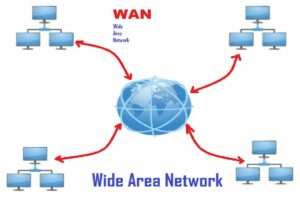Blog
 What Is WAN?
What Is WAN?
Consider a WAN to be a network of interconnected local area networks (LANs). These are the standard one-campus configurations in which all offices are connected together. Consider the fact that metropolitan area networks (MANs) are linked groups of buildings that span a city or town. MANs can also be used in a WAN system.
Assume that an organization has LANs in Boston, New York, and Chicago. To bridge the gap between these locations, the firm must either use a leased line — a specialized connection set up by a service provider — or connect to the public telecommunications network. In these instances, wired and wireless networks security is usually provided using a virtual private network (VPN).
The corporation runs a router at each connectivity endpoint for the LANs in Boston, New York, and Chicago, allowing the LAN to communicate with a hub on the WAN side that handles both outgoing and incoming data. Information packets are being exchanged, and a WAN solution is in place.
Why Are WANs Important for Businesses?
Wide area network solutions are vital for corporate communications because they provide high-speed access while keeping prices low in most circumstances.
Without WAN solutions, the business in the above example would have to own and install every mile of gear connecting its LANs between the three cities. WANs, on the other hand, utilize a far less expensive method, utilizing public technologies to connect one section of the company to another across huge distances. Apart from cost, WANs provide a plethora of new possibilities for firms trying to make the most of their employees’ time, no matter where they are. Working remotely while simultaneously having safe access to company network assets is just one way WANs assist businesses.
Traditionally, WAN Optimization solutions accelerated point-to-point communications between sites. For instance, from the workplace to a data center or cloud service provider. When remote employees, road warriors, and traveling salespeople were not in the office, they were not optimized. This has become a much greater concern in the last two years for the network management system of the companies, with a major portion of the workforce now working from home.
What is the function of a WAN connection?
Today, wide-area networks (WANs) serve as the enterprise’s backbone. Companies utilize WANs to perform the following when digitizing resources:
- Use voice and video to communicate.
- Share resources between customers and staff.
- Access data storage and backup data remotely.
- Connect to apps that are hosted in the cloud.
- Run and host internal apps.
- WAN technology advancements enable enterprises to access information in a safe, rapid, and dependable manner.
- Business productivity and continuity rely on WANs.
WAN Optimization technology –
Wide-area network (WAN) optimization is a collection of technologies and practices used to improve data-transfer efficiency across the WAN. Because it allows you to prioritize traffic and ensure a set amount of available bandwidth for the most vital applications, WAN optimization is an important aspect of network administration. Among the various technologies employed in WAN optimization are:
- Traffic shaping- Traffic is prioritized and bandwidth is allocated accordingly.
- Elimination of redundant data- Also known as data deduplication which decreases the amount of data that must be transferred across a WAN by transmitting references rather than real data.
- Data compression- The process of reducing the size of data in order to reduce bandwidth utilization.
- Data caching- The practice of hosting frequently used data locally or on a local server for quicker access.
- Streamlining data protocols- Combines several requests from talkative apps into a single request.
- Manage bandwidth or quality of service – Limits the amount of bandwidth that certain resource-hogging programs can occupy.
Why is WAN Optimization important?
With advancements in apps, network management systems, cloud computing, and other technologies, WAN optimization has become increasingly more important as the WAN evolves. These key developments are generating an increase in WAN traffic, which will have a major impact on the performance of business-critical applications that transit the WAN. The inherent latency concerns of the WAN, as well as the cost of network bandwidth, are currently big issues for organizations. The two options for addressing this increased bandwidth requirement are to acquire more or to utilize what you already have more effectively through WAN optimization.
What advantages can WAN Optimization provide?
Rapid file access: Caching enables someone who often utilizes the same files to access them more efficiently since only new data must be saved and retrieved rather than the full page needing to be refreshed.
Allows mobile workers and remote locations: With WAN optimization, you may reduce the influence of distance between branch offices, mobile employees, and corporate headquarters. It can increase network speed between distant sites by letting you to swiftly transfer data and perform transactions, hence speeding up network-based communications like e-mail.
Improved performance: non-optimized programs function more smoothly or quicker since bandwidth formerly used for other operations may now be given to the most crucial applications.
More dependable and convenient data recovery: WAN optimization facilitates remote data backup, which is critical for disaster recovery. Furthermore, the ability of WAN optimization to boost network reaction time capabilities helps users to quickly restore access to key applications following a disaster.
Increased efficiency: Protocol enhancements that increase bandwidth consumption and reduce network congestion can help to mitigate the consequences of delay.
Economical: WAN optimization enables application consolidation, which may significantly lower the cost of equipment and software required by a business. Furthermore, it considerably reduces bandwidth expenditures through bandwidth control, compression, caching, and protocol optimization.
If you need assistance figuring out the technicalities, contact COMnet, an IT solutions firm that specializes in complete secure network building and can assist you with incorporating the latest in next generation security and SD WAN solutions and performance management technologies for full WAN optimization.

 What Is WAN?
What Is WAN?